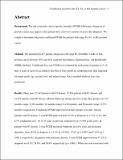| dc.description.abstract | Background: The risk of prostate cancer-specific mortality (PCSM) following a diagnosis of prostate cancer may improve after patients have survived a number of years after diagnosis. We sought to determine long-term conditional PCSM for patients with stage T4, N1, or M1 prostate cancer. Methods: We identified 66,817 patients diagnosed with stage IV (T4N0M0, N1M0, or M1) prostate cancer between 1973 and 2011 using the Surveillance, Epidemiology, and End Results (SEER) database. Conditional five-year PCSM was evaluated for each group of patients at 5, 10, and 15 years of survival according to the Fine & Gray model for competing risks after adjusting for tumor grade, age, income level, and marital status. Race-stratified analyses were also performed. Results: There were 13,345 patients with T4 disease, 12,450 patients with N1 disease, and 41,022 patients with M1 disease. Median follow-up among survivors in the three groups was 123 months (range: 0-382 months), 61 months (range: 0-410 months), and 30 months (range: 0-370 months), respectively. Conditional PCSM improved in all three groups over time. Among patients with T4 disease, 5-year PCSM improved from 13.9% at diagnosis to 11.2%, 8.1%, and 6.5% conditioned on 5, 10, or 15 years of survival, respectively (p < 0.001 in all cases). In patients with N1 disease, 5-year PCSM increased within the first five years and decreased thereafter, from 18.9% at diagnosis to 21.4% (p < 0.001), 17.6% (p = 0.055), and 13.8% (p <0.001), respectively. In patients with metastatic disease, 5-year PCSM improved from 57.2% at diagnosis to 41.1%, 28.8%, and 20.8%, respectively (p < 0.001). White race was associated with Conditional mortality after T4, N1, or M1 prostate cancer--2 a greater increase in conditional survival compared to non-white race among those with T4 or N1 disease. Conclusions: While patients with T4, N1, or M1 prostate cancer are never “cured,” their odds of cancer-specific survival increase substantially after they have survived for 5 or more years. Physicians who take care of patients with prostate cancer can use this data to guide follow-up decisions and to counsel newly diagnosed patients and survivors regarding their long-term prognosis. | en_US |


